



L'argent utilisé dans la fabrication des bracelets de la reine Hétéphérès I provient de Grèce The silver used to make queen Hetepheres I's bracelets came from Greece
Photos: Museum of Fine Arts, Boston
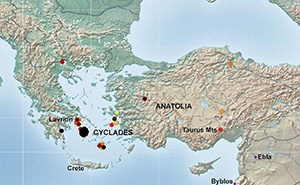
La reine Hétéphérès Ier vécut durant la IVe dynastie -celle des grandes pyramides. Elle a d'ailleurs enfanté et qu'elle a enfanté Khéops (environ 2589–2566 av. J.C.), le roi qui a fait construire la Grande Pyramide de Giza. Dans sa tombe G 7000X, Georges Reisner a découvert en 1925 une série de bracelets en argent qui sont devenues célèbres. Des étude récentes faites sur ces pièces donnent de nouvelles informations sur les réseaux commerciaux qui reliaient autrefois l'Égypte à la Grèce, et ce dès le début de l'Ancien Empire.
Après avoir analysé des échantillons prélevés dans la collection de bijoux du Museum of Fine Arts de Boston, une équipe internationale d'archéologues a déterminé que les bracelets contenaient du cuivre, de l'or et du plomb, ainsi que des incrustations de pierres semi-précieuses. L'une d'entre elles, représentant un papillon, contient également des traces d'argent, bien qu'il n'y ait aucune mine connue de ce métal précieux dans l'Égypte des années 2600 avant J.-C., lorsque les objets ont été fabriqués. Les chercheurs ont déterminé que les matériaux utilisés sont "compatibles avec le minerai des Cyclades", un groupe d'îles grecques de la mer Égée, ou avec le site de Lavrion, une ville du sud de la Grèce (cette dernière origine est cependant peu probable).
En outre, l'imagerie d'une coupe transversale d'un fragment de bracelet révèle que le métal a été recuit et martelé à froid à plusieurs reprises au cours de la fabrication des objets.
Finalement, ces études fournissent de nouvelles informations sur :
1- l'origine du minerai d'argent, qui provient des îles grecques
2- l'existence d'un réseau commercial à longue distance avec les Grecs, plus étendu et beaucoup plus ancien qu'on ne le pensait jusqu'à présent
3 -des caractères particuliers de la métallurgie en Égypte au début de l'âge du bronze.
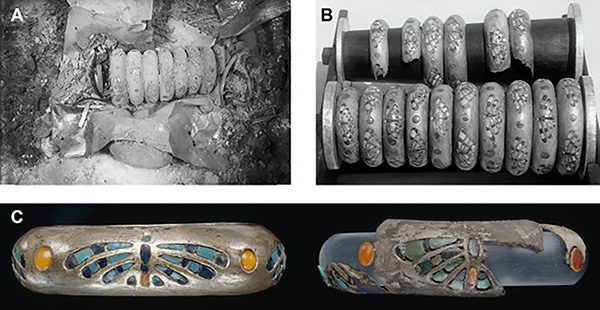

A- Bracelets as found in the tomb. B- Bracelets restaured
C- left - Electrotype reproduction made in 1947 by the MFA. C-right Bracelet in the MFA
Queen Hetepheres I lived during the 4th Dynasty - the dynasty of the Great Pyramids. In fact, she gave birth to Khufu (c. 2589-2566 BC), the king who built the Great Pyramid of Giza. In her tomb G 7000X, Georges Reisner discovered in 1925 a series of famous silver bracelets. Recent studies of these pieces provide new insights into the trade networks that once linked Egypt to Greece, as far back as the beginning of the Old Kingdom. After analyzing samples taken from the jewelry collection in the Museum of Fine Arts, Boston, an international team of archaeologists determined that the bracelets contained copper, gold and lead. There were also inlays made using semiprecious gemstones. One of them, depicting a butterfly, also contained traces of silver, despite there being not any known local sources of the precious metal in ancient Egypt in 2600 B.C., when the items were crafted. The researchers determined that the materials were "consistent with ores from the Cyclades," a group of Greek islands in the Aegean Sea; the site of Lavrion, a town in southern Greece, is also a possibility, albeit a smaller one.
Moreover, imaging of a cross-section of a bracelet fragment reveals that the metal was repeatedly annealed and cold-hammered during creation of the artefacts.
Finally, these studies provide new information on:
1- the sources of silver ore in the greek islands
2- This unveils a long-distance trade network with the Greeks, that was more extensive and significantly older than previously believed
3- The particular characters of metallurgy in Egypt at the beginning of the Bronze Age.
Toutânkhamon aurait été un "guerrier aguerri" et pas un roi-enfant maladif...King Tutankhamun was a 'battle-hardened warrior' and NOT a sickly boy-king...
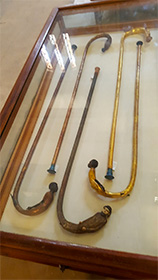
burial equipment
le Dr Campbell Price est conservateur des sections Égypte et Soudan au musée de Manchester. Vous vous souvenez peut-être qu'il a fait sensation en décembre 2022 en affirmant que le but de la momification dans l'Égypte ancienne n'était pas de conserver les corps, mais de les transformer en statues divines.
Lors d'une réunion scientifique, le Dr Price s'en est pris cette fois à "la légende" selon laquelle le jeune roi Toutankhamon était un handicapé qui, pour compenser un pied bot, devait s'appuyer en permanence sur une canne. Et bien sûr, il ne pouvait pas faire d'expéditions militaires dans ces conditions.
Selon Price, trois "experts indépendants" ont affirmé qu'il n'y avait "aucune preuve que le jeune roi ait été handicapé". Mais alors, pourquoi le roi a-t-il été enterré avec environ 130 cannes de formes et de conceptions diverses ? Les égyptologues ont jusqu'à maintenant soutenu qu'il s'agissait de bâtons de marche destinés à compenser son pied bot.
Mais certains experts estiment que le "pied bot" pourrait être un artéfact causé par la momification, au cours de laquelle l'application de résine et un bandage serré auraient pu déformer le pied. Un de ces experts a déclaré : "Les jambes de la momie étaient bien alignées et il n'y a aucun des remaniements osseux compensatoires qu'on aurait du trouver si le jeune homme avait marché plusieurs années avec un pied bot".
Et les cannes ? Campbell Price soutient que les "bâtons de marche" de Toutânkhamon étaient des attributs royaux de pouvoir, car ils étaient ornés de représentations des ennemis de l'Égypte, par exemple des Nubiens. Il pense que "l'image d'un roi faible, handicapé, malade, est très probablement un mythe. Mais cette image est tellement ancrée chez tout le monde qu'il sera très difficile de la changer au profit de celle d'un roi guerrier présent sur les champs de bataille".
Dr Campbell Price, curator of the Manchester Museum's Egypt and Sudan section. You may remember that he caused a stir in December 2022 by claiming that the purpose of mummification in ancient Egypt was not to preserve bodies, but to transform them into divine statues.
This time, at a scientific meeting, he attacked "the legend" that the young King Tutankhamun was a cripple who had to lean permanently on a cane to compensate for a club foot. And of course he couldn't go on military expeditions.
According to Price, three "independent experts" stated that there was "no evidence that the young king was disabled". So why was the king buried with around 130 canes of various shapes and designs in his burial equipment? Until now, Egyptologists have maintained that they were walking sticks designed to compensate for a club foot.
But some people believe that the "clubfoot" could be an artefact caused by mummification, during which the application of resin and a tight bandage could have deformed the foot. One of these experts said: "The mummy's legs were well aligned and there is none of the compensatory bony evidence that would have been found if there had been a clubfoot".
What about the canes? Campbell Price argues that Tutankhamun's "walking sticks" were royal attributes of power, as they were adorned with depictions of Egypt's enemies, such as the Nubians. He believes that "the image of a weak, disabled, sick king is very probably a myth. But this image is so ingrained in everyone that it will be very difficult to change it for that of a warrior king present on the battlefield".
L'Égypte punit le Rijksmuseum van Oudheden (RMO) après une exposition controverséeLeiden museum barred from Egypt excavations after Kemet exhibition
Photos: New York Times et site de l'exposition
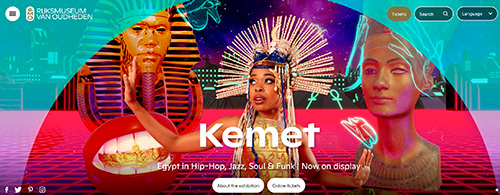
L'Égypte accuse le musée néerlandais de Leyde de "falsifier l'histoire "
en raison de "l'approche afrocentrique" de l'exposition en cours dans le musée, intitulée "Kemet. L'Égypte dans le hip-hop, le jazz, la soul et le funk"
. L'exposition se penche sur "l'importance de l'Égypte ancienne et de la Nubie dans le travail des artistes de la diaspora africaine"
. Inaugurée fin avril, l'exposition a rapidement suscité un flot de réactions négatives, voire racistes, sur les réseaux sociaux égyptiens. Le pays vient d'interdire aux équipes du musée de continuer leur travail sur le site de Saqqara, où elle est pourtant présente depuis 1975 et où elle a fait des découvertes remarquables (par exemple la tombe de Maya et Meryt, ou encore la tombe d'Horemheb avant qu'il ne devienne pharaon).
Le directeur du RMO, Wim Weijland, se dit blessé par la décision des autorités égyptiennes et furieux de l'accusation selon laquelle le musée aurait falsifié l'histoire.
Mais l'exposition présentée au RMO va au-delà de la géographie. Elle explore la tradition des musiciens noirs - Beyoncé, Tina Turner, Nas et d'autres - qui tirent leur inspiration et leur fierté de l'idée que l'Égypte ancienne était une culture africaine. L'exposition est présentée comme un correctif utile à des siècles d'effacement culturel des Africains. L'idée que l'Égypte ancienne est l'ancêtre culturel des Noirs d'aujourd'hui est au cœur de certaines formes d'afrocentrisme. L'exposition examine la manière dont cet afrocentrisme s'est manifesté dans la musique. C'est ainsi qu'on voit Beyoncé et Rihanna parées du costume de Néfertiti ; Nina Simone qui déclare qu'elle est (probablement...) la réincarnation de cette ancienne reine d'Égypte!
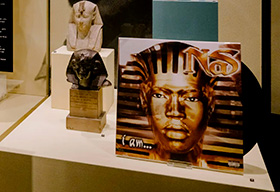
Le gouvernement égyptien et une grande partie de la population ont inondé les pages des réseaux sociaux du musée de plaintes concernant ce qu'ils considèrent comme une "appropriation occidentale de leur histoire"
. En effet, de nombreux Égyptiens ne se considèrent pas du tout comme des Africains et s'identifient beaucoup plus étroitement aux nations arabes du Moyen-Orient et de l'Afrique du Nord, qu'aux Africains. Un membre du Parlement égyptien a déclaré que l'exposition "s'attaque à la civilisation et à l'héritage des Égyptiens"
et "déforme l'identité égyptienne"
.
Pourtant, la colère des Égyptiens était prévisible puisque le caractère sensible de ce sujet était apparu clairement lors de la controverse sur la série "Queen Cleopatra" de Netflix où la reine Néfertiti était africaine. Des voix s'étaient élevées pour demander l'interdiction du service de streaming en Égypte, tandis que le gouvernement qualifiait la série de "falsification de l'histoire de l'Égypte"
.
Et puis, il y a toujours la vieille rancoeur contre les Occidentaux qui ont souvent parlé de l'Égypte ancienne sans impliquer les Égyptiens contemporains.
Le commissaire de l'exposition reste par contre inflexible : pas question qu'il arrête prématurément l'exposition, ni qu'il la modifie.
Egypt has banned the National Museum of Antiquities (RMO) in Leiden from carrying out excavations in Sakkara. The country accused the Dutch museum of "falsifying history" with the "Afrocentric" approach to the RMO exhibition Kemet. Egypt in hip-hop, jazz, soul & funk. The exhibition looks at "the significance of ancient Egypt and Nubia in the work of artists from the African diaspora." It opened at the end of April and was quickly met with a flood of negative and sometimes racist responses on social media from Egypt. And now the country has banned the RMO from Sakkara, where it's been active every year since 1975 and is currently leading an excavation with partners.
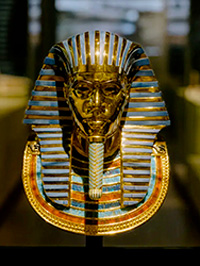
RMO director Wim Weijland is hurt by the Egyptian authorities' decision, and furious about the accusation that the museum falsified history. But the show at the RMO in Leiden goes beyond geography. It explores the tradition of Black musicians — Beyoncé, Tina Turner, Nas and others — drawing inspiration and pride from the idea that ancient Egypt was an African culture. The exhibit is framed as a useful corrective to centuries of cultural erasure of Africans. Suggestions that ancient Egypt is a cultural ancestor of modern-day Black people are central to some forms of Afrocentrism.
The museum exhibit, "Kemet: Egypt in Hip-Hop, Jazz, Soul & Funk," looks at how Afrocentrism has played out in music. Beyoncé and Rihanna have adorned themselves as Nefertiti; Nina Simone said she believed she was Nefertiti reincarnate!!
The Egypt's government and many of its people, who have flooded the museum's Facebook and Google pages with complaints about what they see as Western appropriation of their history. Many Egyptians do not see themselves as African at all, identifying much more closely with the predominantly Arab and Muslim nations of the Middle East and North Africa. The exhibit "attacks Egyptians' civilization and heritage" and "distorts Egyptian identity," a member of Parliament said. For Egyptians, just how touchy this subject is became clear during the controversy over Netflix's "Queen Cleopatra" series, when an Egyptian lawyer called for banning the streaming service in Egypt and the government dismissed the show as a "falsification of Egyptian history."
And then there's always the old grudge against Westerners, who have often talked about ancient Egypt without involving contemporary Egyptians.
On the other hand, the exhibition's curator is adamant that he will not stop the exhibition prematurely, nor will he modify it.
Publications GRATUITES à ne pas manquerDon't miss these free new publications
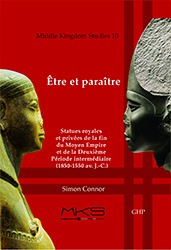
L'excellente collection "Middle Kingdom Studies" (MKS), fondée par Gianluca Miniaci (Università di Pisa) et publiée par Golden House Publications, couvre tous les aspects de l'âge du bronze moyen en Égypte, de 2050 à 1550 av.J.C.
Le dixième volume de la série vient de paraître : Simon CONNOR, "Être et paraître. Statues royales et privées de la fin du Moyen Empire et de la Deuxième Période Intermédiaire (1850-1550 av. J.-C.)" Il a reçu le prix Max Serres de l'Académie des Inscriptions et Belles-Lettres, Paris 2023.
Vous pouvez le télécharger : PDF gratuit
Un autre ouvrage incontournable a été publié par l'Institute for the Study of Ancient Cultures (SAC) de l'Université de Chicago : "SAC 2. Mural Decoration in the Theban Necropolis", édité par Betsy M. Bryan et Peter F. Dorman.
Les tombes et les temples mortuaires de Thèbes sont un sujet d'intérêt permanent grâce à un corpus de matériel de terrain en expansion rapide et à une série de conférences consacrées au sujet. Ce volume, le quatrième, présente de nouvelles recherches sur la décoration murale dans la nécropole thébaine. Ses treize essais, rédigés par un groupe international d'éminents chercheurs, témoignent de l'étendue et de la variété du thème, comme le montre la table des matières
Vous pouvez télécharger un exemplaire au format PDF gratuitement (ça ne va peut-être pas durer) SAC2
The (excellent) series "Middle Kingdom Studies" (MKS), founded by Gianluca Miniaci (Università di Pisa), and published by Golden House Publications, encompasses all aspects of the Middle Bronze Age in Egypt 2050-1550 BC.
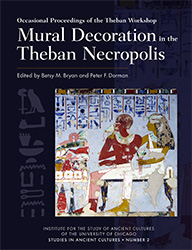
The tenth volume of the series has just been published : Simon CONNOR, "Être et paraître. Statues royales et privées de la fin du Moyen Empire et de la Deuxième Période intermédiaire (1850-1550 av. J.-C.)" It was awarded the Max Serres prize by the Académie des Inscriptions et Belles-Lettres, Paris 2023.
You can download it: PDF for free
Another must-have book has been published by the Institute for the Study of Ancient Cultures (SAC) of the University of Chicago: "SAC 2. Mural Decoration in the Theban Necropolis", edited by Betsy M. Bryan and Peter F. Dorman.
The tombs and mortuary temples of Thebes have proved an enduring topic of interest thanks to a quickly expanding corpus of field materials and a series of conferences devoted to the subject. This volume, the fourth in a series of occasional proceedings from the ongoing Theban Workshop, presents new research on wall decoration in the Theban necropolis. Its thirteen essays, by an international array of leading scholars, attest to the wide and varied scope of the theme, as can be seen in the TOC
Rush to download a copy for free: SAC2
La pyramide de la reine Teticheri en Abydos a été restauréeQueen Teti Sheri pyramid in Abydos restored
Photos: Ministry of Tourism and Antiquities (MoTA)

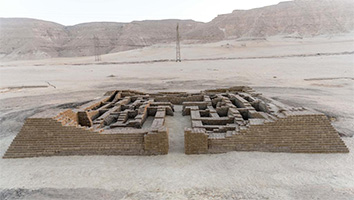
The Tetisheri pyramid after its restoration
Une mission archéologique conjointe égypto-américaine opérant dans le sud d'Abydos a achevé la restauration et l'entretien de la pyramide en briques crues de la reine Teticheri, la dernière pyramide connue d'une reine dans l'Égypte ancienne. Le pharaon Ahmosis Ier a érigé dans sa propre nécropole à Abydos une structure commémorative en l'honneur de Teticheri. Cette structure en briques crues a été découverte en 1902. Il comporte, une stèle détaillant la dédicace par Ahmosis Ier et sa sœur-épouse Ahmès-Nefertari d'une pyramide et d'une enceinte à Teticheri.
Teticheri était la mère du roi Seqenenre, le souverain qui mena la guerre contre les Hyksos.
Les travaux de restauration ont consisté à consolider les fondations et les murs de la pyramide. Il s'agit également de remplacer les parties manquantes afin d'offrir aux visiteurs une vue complète de la pyramide et des méthodes de construction utilisées. La mission a fabriqué une structure légère en bois sur la surface d'origine de la pyramide inclinée - à un angle de 63 degrés - afin de s'assurer que l'angle d'inclinaison des murs était préservé pendant la restauration.
La mission a également mis au jour des vestiges de l'ancienne pyramide et de ses fondations, ainsi que des vestiges de l'ancienne pyramide.
La mission a également mis au jour un cimetière datant de l'époque du roi Ahmosis, ainsi que des ruines qui pourraient être des maisons ou des bâtiments de service datant de la même époque.
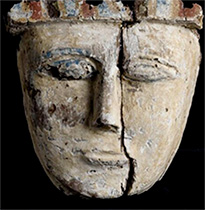
A joint Egyptian-US archaeological mission operating in the south of Abydos has completed the restoration and maintenance of the mud brick pyramid of Queen Tetisheri, the last known pyramid for a queen in Ancient Egypt. Pharaoh Ahmose I erected a memorial structure in her honour in his own necropolis at Abydos. This mudbrick structure was first discovered in 1902. It comprised a stela detailing the dedication by Ahmose I and his sister-wife Ahmose-Nefertari of a pyramid and an enclosure to Tetisheri.
Tetisheri was the mother of King Seqenenre - the ruler who led the war against the Hyksos.
The mission also uncovered a cemetery from the era of King Ahmose alongside ruins that might have been houses or service buildings dating back to the same era.
-- Sent from my Linux system.
No comments:
Post a Comment